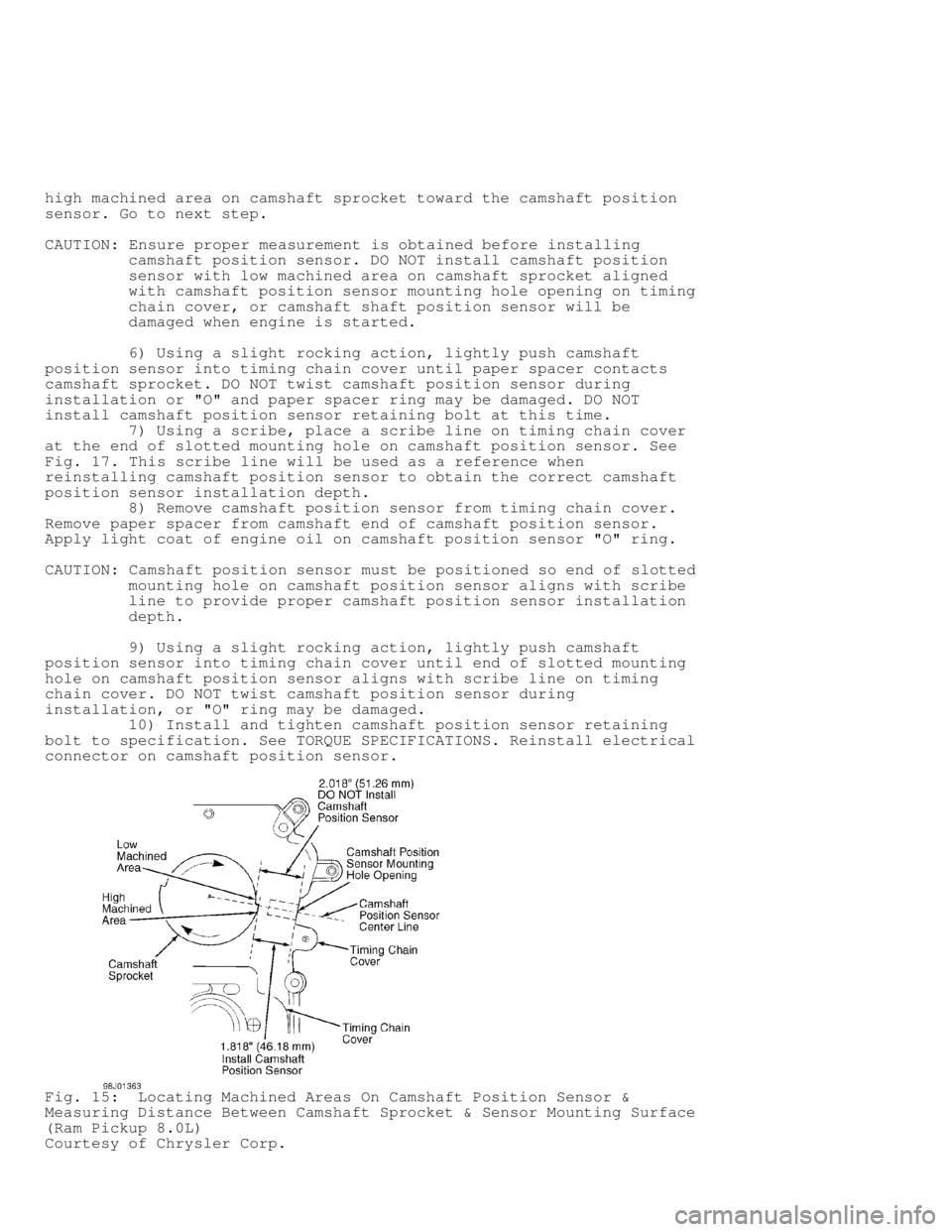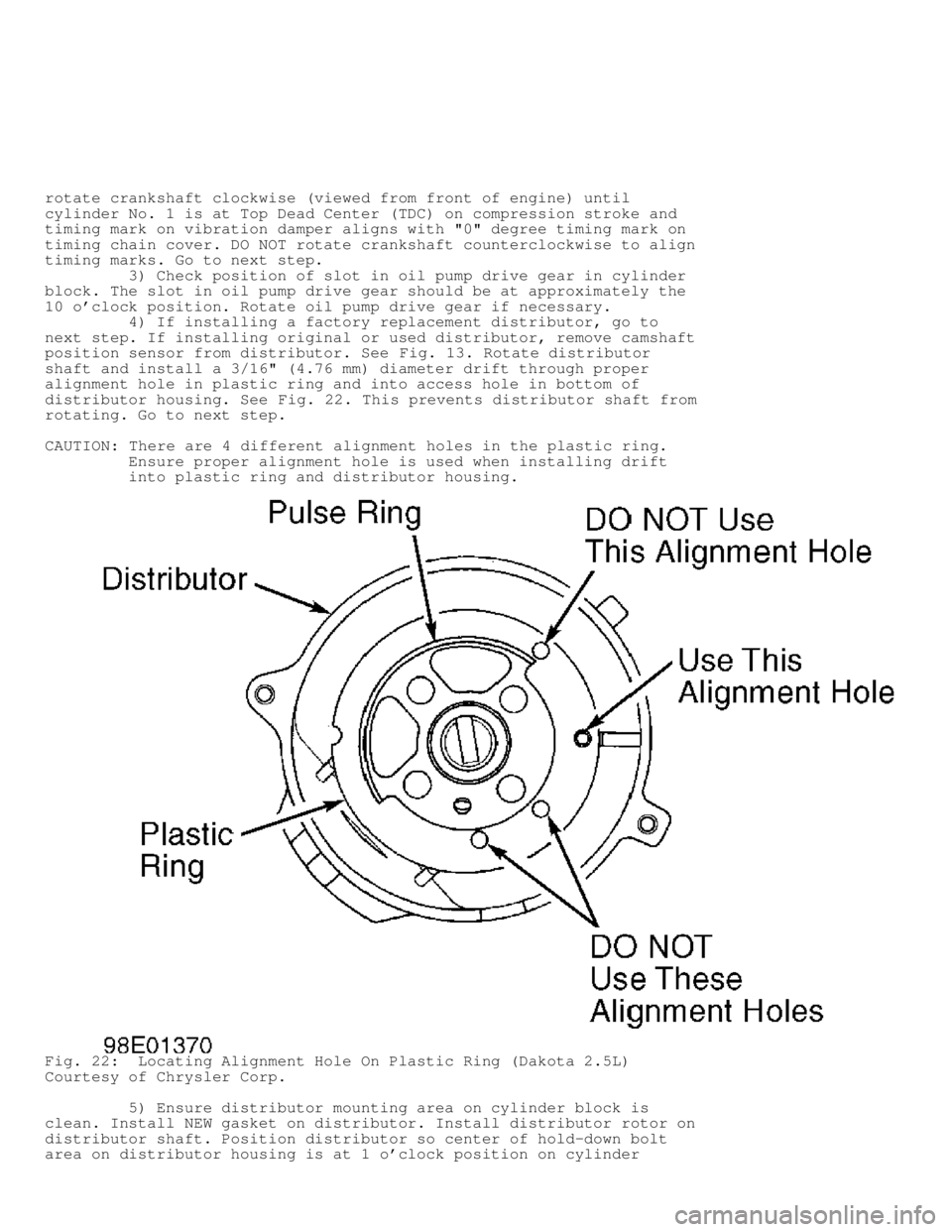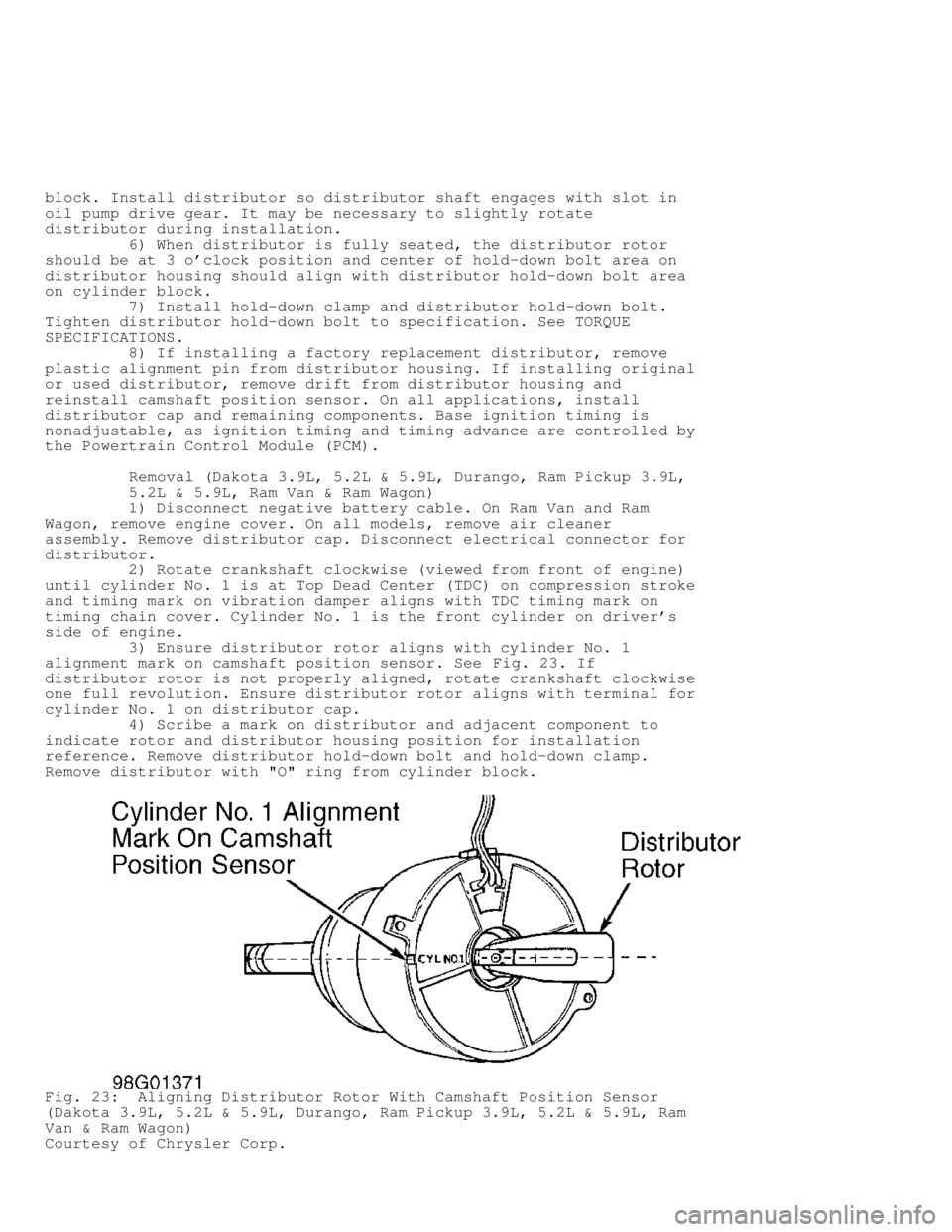1999 DODGE RAM engine oil
[x] Cancel search: engine oilPage 959 of 1691

distance is about 2.018" (51.26 mm), rotate engine by using crankshaft\
vibration damper retaining bolt until distance from the surface at
camshaft position sensor mounting hole opening on timing chain cover
to the camshaft sprocket is about 1.818" (46.18 mm). This will put the\
high machined area on camshaft sprocket toward the camshaft position
sensor. Go to next step.
CAUTION: Ensure proper measurement is obtained before installing
camshaft position sensor. DO NOT install camshaft position
sensor with low machined area on camshaft sprocket aligned
with camshaft position sensor mounting hole opening on timing
chain cover, or camshaft shaft position sensor will be
damaged when engine is started.
3) Using a slight rocking action, lightly push camshaft
position sensor into timing chain cover until rib material at camshaft
end of camshaft position sensor contacts camshaft sprocket. DO NOT
twist camshaft position sensor during installation or "O" ring may be
damaged.
4) Install and tighten camshaft position sensor retaining
bolt to specification. See TORQUE SPECIFICATIONS. Reinstall electrical
connector on camshaft position sensor. When engine is started, rib
material at camshaft end of camshaft position sensor will be sheared
off and the air gap will be automatically set.
Installation (Original Or Used Camshaft Position Sensor)
1) Camshaft position sensor installation depth must be
adjusted to prevent camshaft position sensor from contacting the
camshaft sprocket. Inspect camshaft end of camshaft position sensor to
see if any of the original rib material is still present. See Fig. 16.
The rib material was used to position the camshaft position sensor at
the correct installation depth when the sensor was originally
installed.
CAUTION: DO NOT remove more rib material than necessary or camshaft
position sensor may be damaged. Due to high magnetic field
and possible electrical damage to camshaft position sensor,
DO NOT use electric grinder to remove rib material from
camshaft position sensor.
2) If no rib material exists, go to next step. If any rib
material exists, using razor knife, remove rib material from camshaft
end of camshaft position sensor until rib material is even with end of
camshaft position sensor.
CAUTION: DO NOT fabricate a paper spacer for camshaft end of camshaft
position sensor. Paper spacer from parts department is a
specified thickness for obtaining the correct camshaft
position sensor installation depth.
3) Ensure camshaft end of camshaft position sensor is clean.
Install NEW paper spacer from parts department on camshaft end of
camshaft position sensor. Use only specified paper spacer from parts
department for this camshaft position sensor application.
4) Apply light coat of engine oil on camshaft position sensor
"O" ring. Using a 1/2" wide metal ruler, measure distance from the
surface at camshaft position sensor mounting hole opening on timing
chain cover to the camshaft sprocket. See Fig. 15.
5) If distance is about 1.818" (46.18 mm), go to step 6). I\
f
distance is about 2.018" (51.26 mm), rotate engine by using crankshaft\
vibration damper retaining bolt until distance from the surface at
camshaft position sensor mounting hole opening on timing chain cover
to the camshaft sprocket is about 1.818" (46.18 mm). This will put the\
Page 960 of 1691

high machined area on camshaft sprocket toward the camshaft position
sensor. Go to next step.
CAUTION: Ensure proper measurement is obtained before installing
camshaft position sensor. DO NOT install camshaft position
sensor with low machined area on camshaft sprocket aligned
with camshaft position sensor mounting hole opening on timing
chain cover, or camshaft shaft position sensor will be
damaged when engine is started.
6) Using a slight rocking action, lightly push camshaft
position sensor into timing chain cover until paper spacer contacts
camshaft sprocket. DO NOT twist camshaft position sensor during
installation or "O" and paper spacer ring may be damaged. DO NOT
install camshaft position sensor retaining bolt at this time.
7) Using a scribe, place a scribe line on timing chain cover
at the end of slotted mounting hole on camshaft position sensor. See
Fig. 17 . This scribe line will be used as a reference when
reinstalling camshaft position sensor to obtain the correct camshaft
position sensor installation depth.
8) Remove camshaft position sensor from timing chain cover.
Remove paper spacer from camshaft end of camshaft position sensor.
Apply light coat of engine oil on camshaft position sensor "O" ring.
CAUTION: Camshaft position sensor must be positioned so end of slotted
mounting hole on camshaft position sensor aligns with scribe
line to provide proper camshaft position sensor installation
depth.
9) Using a slight rocking action, lightly push camshaft
position sensor into timing chain cover until end of slotted mounting
hole on camshaft position sensor aligns with scribe line on timing
chain cover. DO NOT twist camshaft position sensor during
installation, or "O" ring may be damaged.
10) Install and tighten camshaft position sensor retaining
bolt to specification. See TORQUE SPECIFICATIONS. Reinstall electrical
connector on camshaft position sensor.
Fig. 15: Locating Machined Areas On Camshaft Position Sensor &
Measuring Distance Between Camshaft Sprocket & Sensor Mounting Surface
(Ram Pickup 8.0L)
Courtesy of Chrysler Corp.
Page 962 of 1691

Removal & Installation (Dakota 2.5L)
1) Crankshaft position sensor is located on driver's side of
engine at transmission bellhousing. See Fig. 18. Remove air inlet duct
between throttle body and air cleaner assembly.
2) Disconnect electrical connector for crankshaft position
sensor. Remove crankshaft position sensor retaining bolts and
crankshaft position sensor.
CAUTION: Retaining bolts for crankshaft position sensor are specially
machined bolts to provide correct clearance between
crankshaft position sensor and the flywheel. DO NOT use any
other type retaining bolts.
3) To install, reverse removal procedure. Tighten crankshaft
position sensor retaining bolts to specification. See TORQUE
SPECIFICATIONS.
Removal & Installation (Dakota 3.9L, 5.2L & 5.9L, & Durango)
1) Crankshaft position sensor is located on passenger side of
engine at transmission bellhousing, just behind the cylinder head. See
Fig. 19 . Passenger's side front fender wheelwell must be removed for
access to crankshaft position sensor.
2) Raise and support vehicle. Remove passenger side front
wheel. Remove wheel opening molding. Remove plastic rivets attaching
wheelwell to front fender. Remove wheelwell.
3) Disconnect electrical connector for crankshaft position
sensor. Remove crankshaft position sensor retaining bolts and
crankshaft position sensor.
4) To install, reverse removal procedure. Tighten crankshaft
position sensor retaining bolts and wheel lug nuts to specification.
See TORQUE SPECIFICATIONS.
Removal & Installation (Ram Pickup 3.9L, 5.2L & 5.9L, Ram Van
& Ram Wagon)
1) Crankshaft position sensor is located on passenger side of
engine at transmission bellhousing, just behind the cylinder head. See
Fig. 19 .
2) On Ram Van and Ram Wagon, remove engine cover. On Ram
Pickup, remove air inlet duct for access to crankshaft position
sensor.
3) On all models, disconnect electrical connector for
crankshaft position sensor. Remove crankshaft position sensor
retaining bolts and crankshaft position sensor.
4) To install, reverse removal procedure. Tighten crankshaft
position sensor retaining bolts to specification. See TORQUE
SPECIFICATIONS.
Removal (Ram Pickup 8.0L)
1) Crankshaft position sensor is located on passenger's side
of cylinder block, just above the oil pan. See Fig. 20.
2) Raise and support vehicle. Disconnect electrical connector
for crankshaft position sensor. Remove plastic tie strap securing
wiring harness to side of cylinder block.
3) Remove crankshaft position sensor retaining bolt. Using 2
small screwdrivers, carefully pry crankshaft position sensor with "O"
ring from cylinder block by rocking crankshaft position sensor back
and forth.
Installation
1) Apply light coat of engine oil on crankshaft position
sensor "O" ring. Install crankshaft position sensor in cylinder block
by rocking crankshaft position sensor back and forth. DO NOT twist
crankshaft position sensor during installation, or "O" ring may be
Page 966 of 1691

rotate crankshaft clockwise (viewed from front of engine) until
cylinder No. 1 is at Top Dead Center (TDC) on compression stroke and
timing mark on vibration damper aligns with "0" degree timing mark on
timing chain cover. DO NOT rotate crankshaft counterclockwise to align
timing marks. Go to next step.
3) Check position of slot in oil pump drive gear in cylinder
block. The slot in oil pump drive gear should be at approximately the
10 o'clock position. Rotate oil pump drive gear if necessary.
4) If installing a factory replacement distributor, go to
next step. If installing original or used distributor, remove camshaft
position sensor from distributor. See Fig. 13. Rotate distributor
shaft and install a 3/16" (4.76 mm) diameter drift through proper
alignment hole in plastic ring and into access hole in bottom of
distributor housing. See Fig. 22. This prevents distributor shaft from
rotating. Go to next step.
CAUTION: There are 4 different alignment holes in the plastic ring.
Ensure proper alignment hole is used when installing drift
into plastic ring and distributor housing.
Fig. 22: Locating Alignment Hole On Plastic Ring (Dakota 2.5L)
Courtesy of Chrysler Corp.
5) Ensure distributor mounting area on cylinder block is
clean. Install NEW gasket on distributor. Install distributor rotor on
distributor shaft. Position distributor so center of hold-down bolt
area on distributor housing is at 1 o'clock position on cylinder
Page 967 of 1691

block. Install distributor so distributor shaft engages with slot in
oil pump drive gear. It may be necessary to slightly rotate
distributor during installation.
6) When distributor is fully seated, the distributor rotor
should be at 3 o'clock position and center of hold-down bolt area on
distributor housing should align with distributor hold-down bolt area
on cylinder block.
7) Install hold-down clamp and distributor hold-down bolt.
Tighten distributor hold-down bolt to specification. See TORQUE
SPECIFICATIONS.
8) If installing a factory replacement distributor, remove
plastic alignment pin from distributor housing. If installing original
or used distributor, remove drift from distributor housing and
reinstall camshaft position sensor. On all applications, install
distributor cap and remaining components. Base ignition timing is
nonadjustable, as ignition timing and timing advance are controlled by
the Powertrain Control Module (PCM).
Removal (Dakota 3.9L, 5.2L & 5.9L, Durango, Ram Pickup 3.9L,
5.2L & 5.9L, Ram Van & Ram Wagon)
1) Disconnect negative battery cable. On Ram Van and Ram
Wagon, remove engine cover. On all models, remove air cleaner
assembly. Remove distributor cap. Disconnect electrical connector for
distributor.
2) Rotate crankshaft clockwise (viewed from front of engine)\
until cylinder No. 1 is at Top Dead Center (TDC) on compression stroke\
and timing mark on vibration damper aligns with TDC timing mark on
timing chain cover. Cylinder No. 1 is the front cylinder on driver's
side of engine.
3) Ensure distributor rotor aligns with cylinder No. 1
alignment mark on camshaft position sensor. See Fig. 23. If
distributor rotor is not properly aligned, rotate crankshaft clockwise
one full revolution. Ensure distributor rotor aligns with terminal for
cylinder No. 1 on distributor cap.
4) Scribe a mark on distributor and adjacent component to
indicate rotor and distributor housing position for installation
reference. Remove distributor hold-down bolt and hold-down clamp.
Remove distributor with "O" ring from cylinder block.
Fig. 23: Aligning Distributor Rotor With Camshaft Position Sensor
(Dakota 3.9L, 5.2L & 5.9L, Durango, Ram Pickup 3.9L, 5.2L & 5.9L, Ram
Van & Ram Wagon)
Courtesy of Chrysler Corp.
Page 968 of 1691

Installation
1) If engine has not been rotated after removing distributor,
go to next step. If engine was rotated after removing distributor,
rotate crankshaft clockwise (viewed from front of engine) until
cylinder No. 1 is at Top Dead Center (TDC) on compression stroke and
timing mark on vibration damper aligns with TDC timing mark on timing
chain cover. Go to next step.
2) Ensure distributor mounting area on cylinder block is
clean. Install NEW "O" ring on distributor if necessary. Apply light
coat of engine oil on "O" ring.
3) Position distributor rotor so it aligns with terminal for
cylinder No. 1 on distributor cap. Install distributor. Ensure
distributor engages with slot in oil pump drive gear. Install hold-
down clamp and distributor hold-down bolt. DO NOT tighten distributor
hold-down bolt at this time.
4) Rotate distributor until distributor rotor aligns with
cylinder No. 1 alignment mark on camshaft position sensor. See Fig. 23
. Tighten distributor hold-down bolt to specification. See TORQUE
SPECIFICATIONS. To install remaining components, reverse removal
procedure.
5) Base ignition timing is nonadjustable. Base ignition
timing and timing advance are controlled by the Powertrain Control
Module (PCM). Distributor position is used to determine the fuel
system synchronization. To check for correct distributor position and
fuel system synchronization, see FUEL SYSTEM SYNCHRONIZATION under
FUEL SYSTEM in ON-VEHICLE ADJUSTMENTS article.
IGNITION COIL
Removal & Installation (Dakota 2.5L)
Ignition coil is located on side of engine, near distributor.
Service procedure is primarily an unbolt and bolt-on procedure.
Tighten ignition coil retaining bolts or nuts to specification. See
TORQUE SPECIFICATIONS.
Removal & Installation (Dakota 3.9L, 5.2L & 5.9L, Durango &
Ram Van/Wagon)
1) Ignition coil is located on front of passenger's side
cylinder head. Disconnect spark plug wires and electrical connector
from ignition coil.
CAUTION: Ignition coil-to-cylinder head mounting bracket bolts hold
the idler pulley for the accessory drive belt, as these bolts
are under tension. If necessary to remove these bolts,
accessory drive belt must be removed first.
2) Remove ignition coil retaining bolts or nuts with ignition
coil from the ignition coil mounting bracket. DO NOT remove ignition
coil-to-cylinder head mounting bracket bolts, as these bolts are under
tension.
3) To install, reverse removal procedure. Tighten ignition
coil retaining bolts or nuts to specification. See TORQUE
SPECIFICATIONS.
Removal & Installation (Ram Pickup 3.9L, 5.2L & 5.9L)
1) On 3.9L, 5.2L and 5.9L with light-duty emissions, ignition
coil is located on front of passenger's side cylinder head. On 5.9L
with heavy-duty emissions, ignition coil is located on top of air
injection pump. On all models, disconnect spark plug wires and
electrical connector from ignition coil.
CAUTION: On 3.9L, 5.2L and 5.9L with light-duty emissions, ignition
coil-to-cylinder head mounting bracket bolts hold the idler
Page 969 of 1691

pulley for the accessory drive belt, as these bolts are under
tension. If necessary to remove these bolts, accessory drive
belt must be removed first.
2) Remove ignition coil retaining bolts or nuts with ignition
coil from the ignition coil mounting bracket. On 3.9L, 5.2L and 5.9L
with light-duty emissions, DO NOT remove ignition coil-to-cylinder
head mounting bracket bolts, as these bolts are under tension. On all
applications, to install, reverse removal procedure. Tighten ignition
coil retaining bolts or nuts to specification. See TORQUE
SPECIFICATIONS.
Removal & Installation (Ram Pickup 8.0L)
1) Two separate ignition coils are located above passenger's
side valve cover. Each ignition coil can be serviced separately. On
all ignition coil applications, disconnect spark plug wires and
electrical connector from ignition coil.
2) Remove ignition coil retaining bolts and ignition coil
from ignition coil mounting bracket. To install, reverse removal
procedure. Ensure ignition coil is mounted on ignition coil mounting
bracket with electrical connector facing downward. Tighten ignition
coil retaining bolts to specification. See TORQUE SPECIFICATIONS.
FUEL SYSTEM
FUEL SYSTEM PRESSURE RELEASE
WARNING: Always release fuel pressure before disconnecting any fuel
injection-related component. DO NOT allow fuel to contact
engine or electrical components.
1) Remove fuel cap from fuel tank. Note location of spring
loaded flapper valve inside fuel tank filler tube assembly. Flapper
valve is located just below the fuel cap area on fuel tank filler tube
assembly. Flapper valve is used as a secondary way of sealing the fuel
tank if fuel cap was not properly tightened.
WARNING: When opening flapper valve inside fuel tank filler tube
assembly, ensure a non-metallic object is used to prevent any
sparks.
2) Using a non-metallic object, push flapper valve inside
filler tube assembly downward to release any pressure from the fuel
tank. Ensure all pressure is released from fuel tank.
3) Remove fuel pump relay from Power Distribution Center
(PDC). Fuel pump relay may be identified by label on inside of PDC
cover. See POWER DISTRIBUTION CENTER (PDC) LOCATION table.
4) On all models, start engine and allow engine to idle until
engine stalls. Attempt to restart engine until engine will no longer
run. Turn ignition off.
CAUTION: Ensure steps 1) through 4) are performed before proceeding.
Steps 3) and 4) must be performed to ensure most of the fuel
pressure is released from fuel rails to prevent an excessive
amount of fuel being delivered into the cylinders.
5) Remaining fuel pressure is released by energizing a fuel
injector. Disconnect electrical connector at any fuel injector.
6) Connect jumper wire between one electrical terminal on
fuel injector and positive battery terminal. Connect another jumper
wire on remaining electrical terminal on fuel injector.
Page 971 of 1691

N - R EM OVE /IN STA LL/O VER HAU L
under FUEL SYSTEM. Disconnect negative battery cable. Ensure disconnect fitting and fuel lines are clean. Note location of releasetab and pull tab on disconnect fitting. See Fig. 24.
CAUTION: Release tab must be pressed downward before removing pull
tab, or pull tab will be damaged. 2) Press release tab downward. Use screwdriver to pry pull tab upward until pull tab separates from disconnect fitting. Removedisconnect fitting from fuel line. Inspect components for damage. Ifdisconnect fitting is damaged, entire assembly must be replaced, asonly pull tab may be replaced. 3) To install, ensure fuel line and disconnect fitting areclean. Lubricate fuel line and disconnect fitting with engine oil.Install disconnect fitting on fuel line until disconnect fittingbottoms on fuel line. 4) Install NEW pull tab until pull tab locks in disconnectfitting. DO NOT reuse old pull tab. Pull on fuel line and disconnectfitting to ensure components are properly locked together. Reconnectnegative battery cable. Start engine and check for leaks. Removal & Installation (Dual Tab)
1) Release fuel pressure. See FUEL SYSTEM PRESSURE RELEASE under FUEL SYSTEM. Disconnect negative battery cable. Ensuredisconnect fitting and fuel lines are clean. Note location of tabs ondisconnect fitting. See Fig. 24.
2) Squeeze both tabs against disconnect fitting. Pulldisconnect fitting from fuel line. The plastic retainer will remain onthe fuel system component being serviced. The "O" rings and spacerwill remain in the disconnect fitting. 3) Inspect components for damage. If disconnect fitting isdamaged, entire assembly must be replaced. The only component that maybe replaced is the plastic retainer. If plastic retainer must beremoved from fuel system component, carefully release the plasticretainer from the fuel system component using 2 screwdrivers. Inspectplastic retainer for cracks or damage. Replace plastic retainer ifdefective. 4) To install, ensure fuel line and disconnect fitting areclean. Lubricate fuel line and disconnect fitting with engine oil.Install disconnect fitting on fuel line until click sound is heard. 5) Pull on fuel line and disconnect fitting to ensurecomponents are properly locked together. Reconnect negative batterycable. Start engine and check for leaks. Removal & Installation (Plastic Retainer Ring)
1) Release fuel pressure. See FUEL SYSTEM PRESSURE RELEASE under FUEL SYSTEM. Disconnect negative battery cable. Ensuredisconnect fitting and fuel lines are clean. Note location of plasticretainer ring on disconnect fitting. See Fig. 24.
NOTE: Plastic retainer ring must be pressed evenly into disconnect fitting. If plastic retainer is not even, it will be difficult to remove disconnect fitting from fuel line. 2) Firmly push disconnect fitting toward the fuel line while pushing plastic retainer ring evenly into disconnect fitting. Withplastic retainer ring fully depressed, pull disconnect fitting fromfuel line. 3) Inspect components for damage. If disconnect fitting isdamaged, entire assembly must be replaced. 4) To install, ensure fuel line and disconnect fitting areclean. Lubricate fuel line and disconnect fitting with engine oil.Install disconnect fitting on fuel line until click sound is heard.